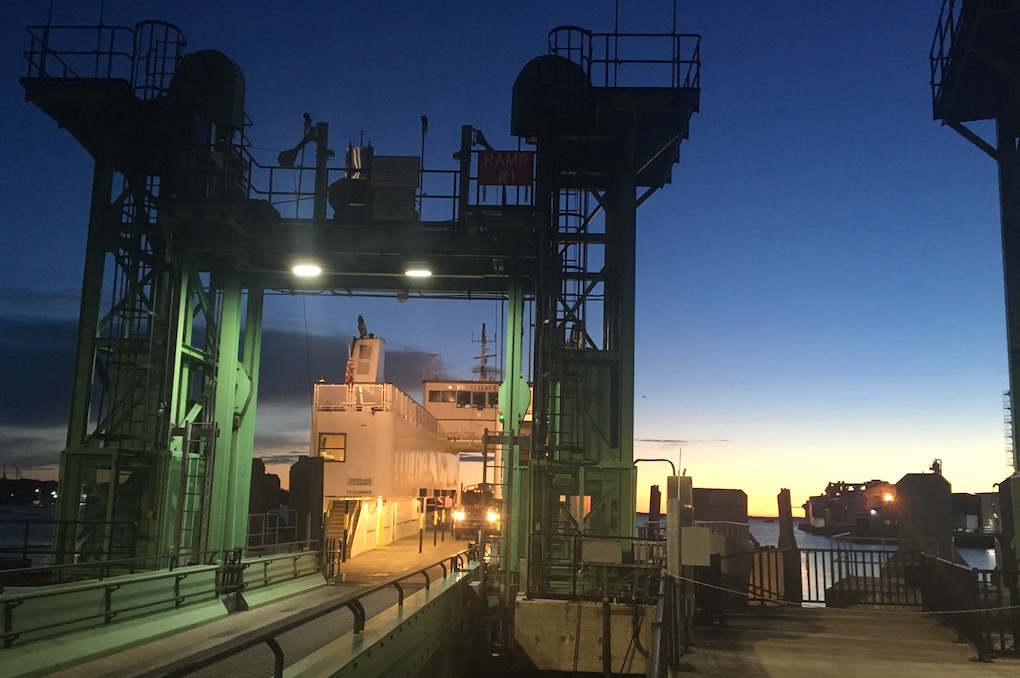By their nature, island communities are beholden to the ferries that serve them, and the ferry schedule, timing, number of trips, and cost all have an impact on island life. In The Working Waterfront and the Island Institute blog, we have covered how changes in the Maine State Ferry Service (MSFS) are impacting Islesboro and the other islands served by the MSFS.
On Wednesday, November 28th, the Maine State Ferry Service held a rulemaking hearing to set fares for the entire system. Background on why this is happening can be found here.
The hearing itself was well covered by TV, radio, and print media. Islesboro residents provided comment after comment about how the rate change is impacting their lives and how they are using the ferry less due to the increase in fares.
The ridership data for Islesboro shows the decline in passengers on the Islesboro run since the new fares went into effect. The time period between the beginning of June and the end of October 2018 saw 16,117 fewer passenger trips and 8,575 fewer vehicle trips as compared to the same period in 2017. These represent a 14% and 20% decline respectively. It is also worth noting that the shoulder months–June, September, and October–have larger decreases in percent ridership than those for the overall period.
To help put these numbers in context, 16,000 passenger trips is about half of the total ridership on the North Haven ferry during this period and is roughly the same as the total passenger ridership in September on the Vinalhaven or Swan’s island run. All of the islands served by the MSFS should be concerned about these numbers. If trends continue, MSFS will likely face a shortfall in projected revenue which may well trigger a surcharge or across-the-board fare increase.
In addition to the rate increase, the MSFS is also coming under scrutiny for how it is handling changes to Vinalhaven’s last run. These articles from the Bangor Daily News and Village Soup outline the issue. Both articles reference the Vinalhaven Risk Assessment or more formally, the “Vinalhaven Route Safety Assessment Report”.
The risk assessment also led to a system-wide change in enforcing the policy of no vehicles running while the boat is moving. While this policy is inconvenient for many, it may be dangerous for others. In particular, if emergency vehicles transporting patients to the hospital have to turn their engines off, they may lose the ability to run various life support systems and on a cold winter day, the lack of heat could compound underlying medical issues. The ferry service is in the process of exploring whether such an exception is possible and what it might look like. Hopefully, there will be some good news on this front soon.
In better news, the Maine State Ferry Service is starting to implement a preventative maintenance system that will hopefully keep the ferries running and mean fewer or shorter yard visits. The MSFS and MEDOT have about $55m in capital expenditures planned for the next X years. This includes three new ferries. The last new ferry, the Thompson, took over a decade to move through the process—and having the foresight to plan for the replacement of not only one but three aging ferries is much appreciated. One of these ferries has been designed and the construction contract awarded to Washburn Doughty. The other ferries are in various stages of planning or design.
While it is exciting to have new ferries coming online, building new ferries that are of a similar design to the ones they are replacing, means locking in 20, 30 or 40 years of staffing and fuel costs. Tying this back to the new rate structure the MSFS may well find itself with a chronic revenue shortfall driven by a downward spiral of declining ridership. It is important for all of us to be looking to the future and be open to new conversations about how ferries and island life intersect.
Other states have ferry services or have contemplated starting them and we could learn a lot from them. For example, Hawaii Department of Transportation recently completed a feasibility study on providing inter-island ferry service and while they deemed providing the service not feasible for a variety of reasons, the report has a table that outlines some information like ownership, largest vessel capacity, and sources of revenue for 160 ferry services across the country. Those who are particularly interested in how ferries operate elsewhere may find some of the information in this report helpful.
More than anything, the communities served by the MSFS are all unique and all dependent in their own way on the ferry service and the ferry service helps to shape and define island life.
I am committed to this community, I am committed to the island and the school. But how much longer I can afford this commitment I do not know. Island communitites are important to the state, and island teachers are important to island schools; it would be shortsighted to overlook [the MSFS] role in reducing Islesboro’s sustainability.”
–Kristen Kelley, teacher
Decisions about the future of Maine’s ferries should be based on a shared understanding of the relevant information, made in the open and after significant public input into consideration. Ideally, the ferry service sees itself as not only the provider of transportation to the general public but also as a true partner in sustaining each island community. After all, the fate of the ferry service and island communities are closely linked.


